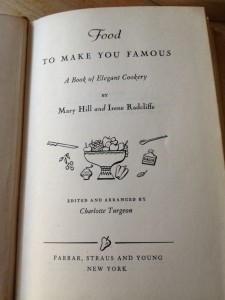by Caroline

As anyone who follows me on Twitter or Facebook is aware, I have started 2012 not in the kitchen, but in my garage. Like any family, we store plenty of things that we won’t need ever again but can’t quite bear to part with (my wedding dress; the boys’ knit hats from the hospitals in which they were born). We also store things that we only need a couple of times a year (ski clothes; camping equipment); emergency kits; and sports equipment. All of that, I have to say, is fairly well organized in labelled boxes.
Like many families, too, we store things we’ve inherited. My late father-in-law’s paintings and sketch books; catalogues from his shows; artwork by his friends. Also, bottles and bottles of the wine he made. Tony built racks for the paintings and periodically culls the wine, and this part of the garage doesn’t make me too anxious. It’s my late mother-in-law’s things, her address books and photo albums and stock notes and newspaper clippings and jewelry and correspondence, that are, frankly, a mess. She saved everything (I wrote a whole essay once about the abundant supplies in her kitchen) and organized nothing. My own grandmother was known for “filling a desk” and then sending it up to the attic for her descendants to deal with, and Nancy operated somewhat similarly. Anything special was saved in a pile, and then eventually scooped into a box, which ultimately went into her garage. When she died, we were too shocked and sad to do anything but move all her crazy boxes into our garage until we could cope.
Every year or so, I dive in and unearth treasures: one box might hold a string of pearls, a menu from Harry’s Bar (circa 1962), newspaper clippings about artist friends’ shows, a few postcards (some blank, some addressed to Nancy), a baby rattle, a pile of Italian stamps. But the way her garage became inserted in mine, it’s like excavating layers of an ancient city. I can only do so much before I need to retreat and gear up for another dig.
This dig, like earlier expeditions, has also unearthed cookbooks. Nancy was a fabulous cook, known for her dinner parties, and among all the letters I’ve found, I’m starting to make a separate file for the “thank you for the wonderful meal” notes. The cookbooks — Elizabeth David’s French Country Cooking (1952), The Perfect Hostess Cook Book (1950), The Brown Derby Cookbook (1949), “Master Chef” Louis P. De Gouy’s Gold Cookbook — with an introduction credited simply to “Oscar of the Waldorf-Astoria” — (1947) — these get to come upstairs. I may never cook from them, but they are fabulous reading, a sweet glimpse back at a different time in American cooking and an insight into another generation.
The cookbook I’m currently loving the most, just for its title, is Mary Hill and Irene Radcliffe’s Food to Make You Famous. I’ve just never thought about food this way. Food to fuel you through the day, sure; food to make your family happy, food to use up leftovers or the new vegetables in your CSA share, but food to make you famous? Maybe I should be thinking about food this way! I’ve paged through to see if I can tell what Nancy cooked from this book. Many recipes have check marks, like Clam Chowder, Hungarian Goulash, Glazed Carrots, Oatmeal Bread (Oatmeal Bread can make you famous?), Chicken Marco Polo and most of the beef recipes (except, thankfully, Epicurean Baked Beef Tongue Stuffed with Sweetbreads, Olives and Mushrooms) and the page with Maitre d’Hotel Butter (COLD) and Maitre d’Hotel Sauce (HOT) is splattered with some of that sauce. Aside from that one bread recipe, there’s not a single mark in any of the baking sections, but as this book leads me from the garage back to the kitchen, that’s where I think I’ll start, and I’ll report back. English Yeast Crumpets? Sweetheart Rolls? Maybe the food will make me famous.
